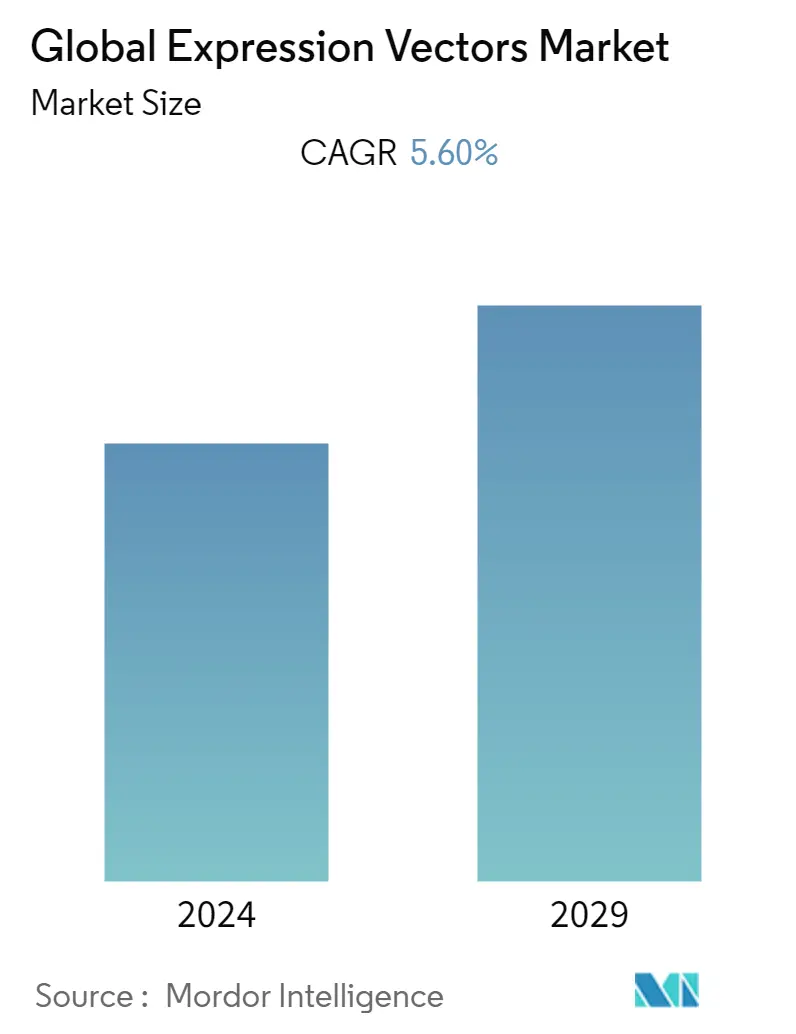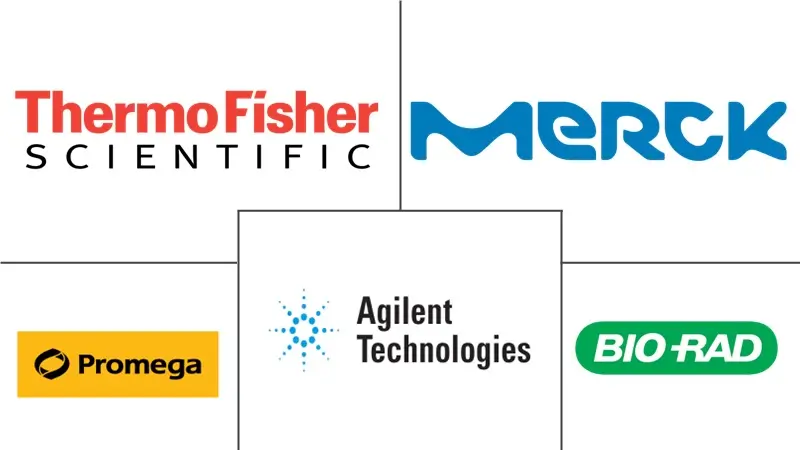Market Size of Global Expression Vectors Industry

| Study Period | 2019 - 2029 |
| Base Year For Estimation | 2023 |
| CAGR | 5.60 % |
| Fastest Growing Market | Asia-Pacific |
| Largest Market | North America |
| Market Concentration | Medium |
Major Players
*Disclaimer: Major Players sorted in no particular order |
Expression Vectors Market Analysis
The expression vectors market is expected to register a CAGR of 5.6% over the forecast period, 2022-2027.
The market has a slightly positive impact due to the pandemic. The development of therapeutic and preventive strategies requires an accurate understanding of the role that proteins play in the SARS-CoV-2 infection process and progression of COVID-19. The vast field of proteomics is well equipped with the technologies needed to help in facing this challenge. In an article published in the Journal of Proteins and Proteomics in October 2020, researchers have highlighted that the developments in proteome technologies will not only accelerate progress in addressing the coronavirus pandemics but could also prove invaluable in tackling the current COVID-19 crisis. According to a report published by Journal of the American College of Cardiology: Basic to Translational Science, on Plasma Proteomics of COVID-19-Associated Cardiovascular Complications, on May 2022, key biological pathways linked to cardiac injury and stress in COVID-19 are identified by plasma proteomics. The von Willebrand factor (VWF)-cleaving protease ADAMTS13 (a disintegrin and metalloproteinase with thrombospondin type 1 motif, 13), whose loss-of-function results in microvascular thrombosis, exhibits the most significant inverse correlation with myocardial damage among the 4,996 analytes examined in COVID-19. The market is expected to gain traction due to the significant increase in the COVID 19 cases globally.
The propelling factors for the growth of the expression vector market include the rise in the R&D activity in the pharmaceutical sector, opportunities in the field of proteomics, and advancements in the biologics market set to boost the market growth and the increasing incidences of lifestyle diseases, infectious diseases and genetic disorders. According to the World Health Organization (WHO) 2021, non-communicable diseases (NCDs) are causative of 41 million deaths yearly, equivalent to 71% of the total death rate. More than 15 million people die each year from non-communicable diseases between 30 and 69 years. About 85% of these "premature" deaths occur in low- and middle-income countries. Also, 77% of all non-communicable disease casualties are in low- and middle-income countries. Cardiovascular diseases account for most non-communicable disease deaths, or 17.9 million fatalities annually, followed by cancers (9.3 million), respiratory diseases (4.1 million), and diabetes (1.5 million). These growing cases of non-communicable diseases are expected to further increase the demand for biologics in treating chronic diseases. Biologics have played a crucial role in the treatment process of many health issues. The growing demand for biologicals increases the prospects of its manufacturing using the expression vector systems, thus, boosting the market growth.
Therefore, the factors mentioned above are attributed collectively to the studied market growth over the forecast period. However high cost of protein expression systems is expected to hinder the market growth over the forecast period.
Expression Vectors Industry Segmentation
As per the scope of the report, expression vector, also known as an expression construct, are plasmid or virus that is specially designed for expressing genes in a cell. It is a vector widely used for protein production. The expression vectors market is segmented by Host Type (Bacterial Expression Vectors, Mammalian Expression Vectors, Insect Expression Vectors, Yeast Expression Vectors and Other Expression Vectors), Application (Therapeutic Applications, Research Applications and Industrial Applications), End-User (Pharmaceutical and Biotechnology Companies, Contract Research Organizations (CROs) and Contract Manufacturing Organizations (CMOs), and Academic Research Institutes), and Geography (North America, Europe, Asia-Pacific, Middle East and Africa, and South America). The market report also covers the estimated market sizes and trends for 17 different countries across major regions, globally. The report offers the value (in USD million) for the above segments.
| By Host Type | |
| Bacterial Expression Vectors | |
| Mammalian Expression Vectors | |
| Insect Expression Vectors | |
| Yeast Expression Vectors | |
| Other Expression Vectors |
| By Application | |
| Therapeutic Applications | |
| Research Applications | |
| Industrial Applications |
| By End-User | |
| Pharmaceutical and Biotechnology Companies | |
| Contract Research Organizations (CROs) and Contract Manufacturing Organizations (CMOs) | |
| Academic Research Institutes |
| Geography | ||||||||
| ||||||||
| ||||||||
| ||||||||
| ||||||||
|
Global Expression Vectors Market Size Summary
The expression vectors market is poised for growth, driven by advancements in proteomics and the increasing demand for biologics to address lifestyle diseases, infectious diseases, and genetic disorders. The market's expansion is supported by the rising research and development activities in the pharmaceutical sector and the significant role of expression vectors in the production of recombinant proteins. The COVID-19 pandemic has further highlighted the importance of proteome technologies, which have been instrumental in understanding the virus's impact and developing therapeutic strategies. Despite the high costs associated with protein expression systems, the market is expected to benefit from the growing need for biologics in treating chronic diseases, thereby boosting the adoption of expression vector systems.
North America emerges as the dominant region in the expression vectors market, attributed to its robust healthcare infrastructure and active research and development initiatives. The United States, in particular, is witnessing increased investment in synthetic biology and protein technologies, fueling the market's growth. The competitive landscape is characterized by the presence of several global and regional players, including Thermo Fisher Scientific, Promega Corporation, and Merck KGaA, who are expanding their capabilities through strategic mergers and acquisitions. These developments, along with the rising acceptance of gene and monoclonal antibody-based therapies, are expected to drive the market's growth trajectory over the forecast period.
Global Expression Vectors Market Size - Table of Contents
-
1. MARKET DYNAMICS
-
1.1 Market Overview
-
1.2 Market Drivers
-
1.2.1 Increase in Demand of Protein-Based Biologics
-
1.2.2 High Prevalence Rate of Lifestyle Diseases, Infectious Diseases and Genetic Disorders
-
1.2.3 Funding for Protein Research
-
-
1.3 Market Restraints
-
1.3.1 High Cost of Protein Therapy
-
-
1.4 Porter's Five Force Analysis
-
1.4.1 Threat of New Entrants
-
1.4.2 Bargaining Power of Buyers/Consumers
-
1.4.3 Bargaining Power of Suppliers
-
1.4.4 Threat of Substitute Products
-
1.4.5 Intensity of Competitive Rivalry
-
-
-
2. MARKET SEGMENTATION (Market Size by Value - USD million)
-
2.1 By Host Type
-
2.1.1 Bacterial Expression Vectors
-
2.1.2 Mammalian Expression Vectors
-
2.1.3 Insect Expression Vectors
-
2.1.4 Yeast Expression Vectors
-
2.1.5 Other Expression Vectors
-
-
2.2 By Application
-
2.2.1 Therapeutic Applications
-
2.2.2 Research Applications
-
2.2.3 Industrial Applications
-
-
2.3 By End-User
-
2.3.1 Pharmaceutical and Biotechnology Companies
-
2.3.2 Contract Research Organizations (CROs) and Contract Manufacturing Organizations (CMOs)
-
2.3.3 Academic Research Institutes
-
-
2.4 Geography
-
2.4.1 North America
-
2.4.1.1 United States
-
2.4.1.2 Canada
-
2.4.1.3 Mexico
-
-
2.4.2 Europe
-
2.4.2.1 Germany
-
2.4.2.2 United Kingdom
-
2.4.2.3 France
-
2.4.2.4 Italy
-
2.4.2.5 Spain
-
2.4.2.6 Rest of Europe
-
-
2.4.3 Asia-Pacific
-
2.4.3.1 China
-
2.4.3.2 Japan
-
2.4.3.3 India
-
2.4.3.4 Australia
-
2.4.3.5 South Korea
-
2.4.3.6 Rest of Asia-Pacific
-
-
2.4.4 Middle East and Africa
-
2.4.4.1 GCC
-
2.4.4.2 South Africa
-
2.4.4.3 Rest of Middle East and Africa
-
-
2.4.5 South America
-
2.4.5.1 Brazil
-
2.4.5.2 Argentina
-
2.4.5.3 Rest of South America
-
-
-
Global Expression Vectors Market Size FAQs
What is the current Global Expression Vectors Market size?
The Global Expression Vectors Market is projected to register a CAGR of 5.60% during the forecast period (2024-2029)
Who are the key players in Global Expression Vectors Market?
Thermo Fisher Scientific, Inc., Promega Corporation, Merck KGaA, Agilent Technologies and Bio-Rad Laboratories are the major companies operating in the Global Expression Vectors Market.

